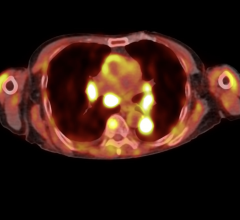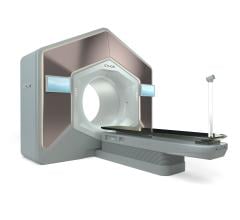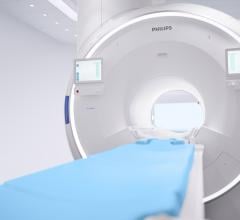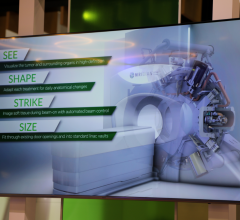While gated imaging has made significant strides in improving precision and accuracy in delivering radiation dose, the radiation oncologist’s bane still remains how to avoid radiating surrounding healthy tissue.
In the last year, there have been enhancements to existing technologies, in particular intensity-modulated radiation therapy (IMRT), image-guided radiation therapy (IGRT) and stereotactic radiosurgery (SRS), that have made precision more accurate than ever.
But which of these systems most effectively narrows margins, targets moving tumors and also limits side effects?
Challenging Tumors, Increasing Demands
One of the challenges of delivering radiation treatment is the dynamic nature of tumors. Because tumors move between and during treatments, oncologists compensate for this movement by either widening the margins surrounding the tumor or making the radiation beam larger. Additionally, many tumors are oddly shaped, difficult to access and nestled among critical organs. The radiation oncologist’s first recourse is in treatment planning, creating a 3D model of the tumor and the surrounding organs to contour the shape of radiation beams to the exact size and shape of the tumor. Still, the dynamic and irregular shape of tumors often results in exposing healthy tissue to radiation.
In response to the need to deliver high-intensity doses with greater precision, manufacturers have improved upon existing technology - IMRT, IGRT and SRS systems - with faster and more agile delivery systems.
“We’re making use of intensity modulation more these days for highly conformal plans,” said Jay Burmeister, Ph.D., DABR, chief of physics at Karmanos Cancer Center and director of education in radiation oncology, Wayne State University School of Medicine. “But when we move toward these highly conformal treatment plans, the risk is far greater. Certainly in the old days when we used radiation with much larger fields, we irradiated significant amounts of normal tissue, but tumor targeting was not as critical. Whereas here, if we’re ultra conformal, we can not only irradiate healthy tissue but miss part of the target as well. We have the potential for double jeopardy.”
As a result, radiation oncology as a field is looking for tools to better target radiation, particularly for tumor movement. With the advent of highly advanced targeting technology, many radiation oncologists are able to provide more patient safety and better efficacy at the same time.
The Need for Speed
New technologies are enhancing IGRT targeting and treatment through multiple means, whether its helical radiation delivery, lightning-fast dosing or a variety of arc choices. What distinguishes one system from the other is the method for dose distribution.
The TomoTherapy Hi-Art system delivers radiation through beams emitted in a spiral. The goal and the result is a higher focus on the tumor and less on vulnerable surrounding structures. The TomoTherapy system involves creating a CT image immediately prior to treatment, enabling radiation oncologists to adjust the tumor position and radiation before and during treatment. The Hi-Art delivers radiation continuously with thousands of narrow beamlets, from all angles around the patient, all targeting the specific tumor position and shape.
“What separates Hi-Art from other systems we’ve used in the past is its dose distribution capability,” said Burmeister, a Hi-Art user. “When you incorporate rotational, helical delivery as opposed to a few discrete beams, you have the possibility for better plan quality, especially with complex cases. For a relatively simple convex tumor, you won’t find much difference between IMRT delivery systems. But when you’re trying to treat large or irregularly shaped targets, with organs at risk in close proximity, the rotational therapy with Hi-Art can be far superior to static-beam IMRT.”
Burmeister and his clinic’s case distribution, including prostate, lung and head and neck tumors, features many tough jobs that defy conventional IMRT. As such, the Tomo system is often their go-to machine for complex cases.
“The way the Tomo treats patients is fundamentally different than static-beam IMRT,” said Burmeister. “In addition to the increased number of IMRT beamlets available, you end up treating individual regions of tissue in shorter time, even though the overall treatment time could be longer. Since patients are moved through a slit of radiation, the time for any individual volume of tissue to receive its radiation dose is smaller than for conventional IMRT. Getting the absorbed dose into the target in a shorter amount of time prevents tumor cells from repairing during a treatment course. Tomotherapy and volumetric arc therapies share this advantage over traditional IMRT delivery methods.”
The Varian Medical Systems RapidArc combines the use of both IMRT and IGRT to deliver a treatment in less than two minutes. By producing as little as 600 MU per fraction compared to up to 3,000 MU in conventional IMRT, using a single 360-degree rotation and shaving treatment time to two minutes or less, radiation is delivered to the whole volume of the tumor in record time, minimizing discomfort and side effects.
At the Center for Radiation Therapy in Beverly Hills, Suzanne Evans, RTT, utilizes the treatment for prostate patients, esophageal patients, pancreatic and in particular head and neck tumor patients, as well as many other types of cancers.
“I’ve been working in therapy for a long time, and I know for our patients it’s very uncomfortable to lie still and wear a mask,” said Evans. “When IMRT became our standard, treatments were extended. By doing RapidArc, the radiation is delivered much more quickly and the patient is on the table less. With our prostate patients, the fiducials can actually move due to gas, excess stool and not enough urine in the bladder. So by doing RapidArc, there’s less time for the prostate to move and the treatment becomes more accurate.”
While some might be skeptical of the efficacy of a drastically reduced treatment time, studies by Varian indicate RapidArc compares favorably with conventional and helical IMRT treatment. In one example, a multitarget cancer of the nasopharynx, RapidArc plans were found to be equivalent or better at target coverage for all targets, and superior in protecting critical structures, including the spinal cord, brainstem, eyes, optic nerve and chiasm, parotid glands and brain.
The Elekta Volumetric Modulated Arc Therapy (VMAT) is designed to enhance the nature of IMRT treatment through precise customization. Treatment planning can incorporate a single arc, multiple arcs, partial arcs or a combination depending on the physician and patient. The choice of arcs is intended to create precise dose control and to avoid vulnerable organs and structures.
Treatment with the VMAT can rival the RapidArc in speed, with total treatment times as short as two minutes. The speed means less discomfort and potential side effects for the patient, while for the physician it allows for potentially improved outcomes and additional patients in the institution.
Robots Among Us
While the Hi-Art, RapidArc and VMAT are still considered cutting-edge, they are increasingly familiar to radiation oncologists, and on the wish list of many centers. But is there a different technology along the spectrum of advanced targeting?
The CyberKnife Robotic Radiosurgery System is designed to noninvasively treat tumors throughout the body and particularly in delicate areas. The system uses robotic arms and continual image guidance to track, detect and correct for tumor and patient movement before and during treatment. Gantry rotations are eliminated, and the robotic mobility allows for automated noncoplanar treatments; together this treatment mechanism is designed to be accurate and customized for the most complex tumors.
CyberKnife enables radiation oncologists to precisely treat intracranial and extracranial tumors in the spine, lung, prostate, liver and pancreas. The treatment process utilizes the skeletal structure of the body as a reference, eliminating the need for bone fiducials or head or body frames typically used for stabilization, minimizing discomfort.
While other systems have been more widely adopted in radiation oncology, demand for the CyberKnife is growing; in 2007, the 100th system was installed in France, and availability has increased by 50 percent since. Ultimately, radiation oncologists view the tool as another powerful option for inoperable or surgically complex tumors.
Through new advances in targeting technology, radiation oncologists are discovering more options for delivering high-intensity, low-risk treatment to complex, moving and irregularly shaped tumors.
Feature | February 12, 2009 | Amy Lillard
New approach to technology gives IMRT, SRS a boost.
© Copyright Wainscot Media. All Rights Reserved.
Subscribe Now


 December 02, 2025
December 02, 2025 









